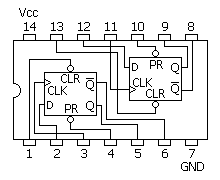- Components
Condenser Mic
555 Timer IC
Transistor BC547
Resistors (1k, 47k, 100k ohm)
IC7474 [ DM74S74N (D-type flip-flop) ]
Capacitors(22nf,10uf)
I have reduced the complexity of the circuit and made it simpler
Capacitors(22nf,10uf)
I have reduced the complexity of the circuit and made it simpler
Here we are using Electric Condenser Mic for sensing the sound and converting it into electric signal, transistor to trigger the 555 timer IC, 555 IC to SET & RESET the D-type flip-flop and D-type flip-flop to remember the logic level (Relay ON or OFF) until next Clap/sound.
Here we are using 555 timer IC in Monostable Mode, whose output can be obtained at PIN 3
Working of D Flip Flop
Here we are using Positive Edge Triggered D-type flip-flop, which means this flip flop only responds when clock pulse would go from LOW to HIGH. The Flip-flop remembers the previous output i.e. High or Low until the next clock pulse.
We have used IC DM74S74N of 7474 series. IC DM74S74N is the Dual D-type Flip-flop IC, in which there are two D-type Flip-flops, which can be either used individually or as a master-slave toggle combination. We are using one D-type Flip-flop in our circuit. Pins for first D flip-flop are the left side and for second flip flop are at right side. Also there are PRE and CLR pins for both the D-type Flip-flops which are active-low pins. These pins used to SET or RESET the D-type Flip-flop respectively, regardless of Input and Clock. We have connected both Vcc and ground to make the IC active.
NOTE:-
NOTE:-
- This circuit works with any 7474 series.






